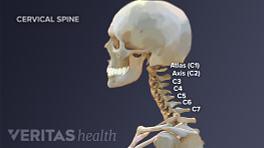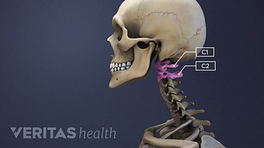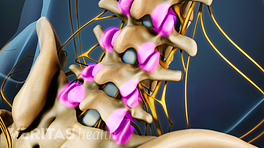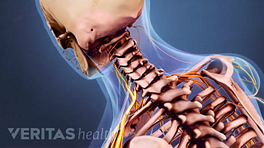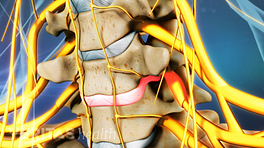The C1 C2 spinal motion segment, also called the atlantoaxial joint, is located in the upper portion of the cervical spine. It consists of the C1 and C2 vertebrae, and the anatomical structures connecting them. This segment provides rotational motion, supports the head, and protects the spinal cord and nerve pathways.
The C1 and C2 vertebrae are connected in the back by a pair of facet joints. The ring-shaped atlas rotates around the dens, which is the peg-like bony projection of the axis.
Articular cartilage enables the smooth movements around the dens and within the facets, while muscles, tendons, and ligaments help hold the vertebrae together. A strain or tear to any of these tissues can cause neck pain and stiffness. If calcium accumulates on ligaments surrounding the dens, a rare condition called crowned dens syndrome may develop.
The spinal cord lies within the vertebral foramen, a space formed by the vertebral arch and vertebral body.
The C2 spinal nerve branches out from the spinal cord on each side between the vertebrae. It receives sensory information from the sides of the face and back of the head. The C2 nerve also has a motor component that sends signals to various muscles, such as the neck flexors.
Spinal conditions, such as facet joint osteoarthritis, may irritate the C2 nerve and cause radicular pain, tingling, numbness, and weakness along the path of the nerve. If the spinal cord is compressed at the C2 spinal level, it may cause pain and neurological deficits in the arms, legs, or anywhere below the level of compression.
In This Article:
- The C1-C2 Vertebrae and Spinal Segment
- C1-C2 Treatment
- Spinal Motion Segment: C1-C2 (Atlantoaxial Joint) Animation

